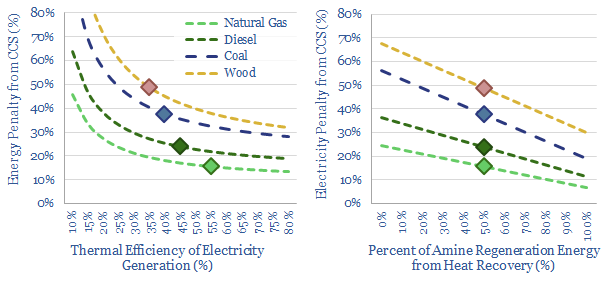A thermal power plant converts 35-45% of the chemical energy in coal, biomass or pellets into electrical energy. So what happens to the other 55-65%? Accessing this waste heat can mean the difference between 20% and 60% energy penalties for post-combustion CCS. This 10-page note explores how much heat can be recaptured.
What are CCS energy penalties? We define CCS energy penalties as the loss of useful energy across an end-to-end CCS value chain, versus the useful energy that would have been available without using CCS. They include direct electricity use (e.g., for CO2 compression in pipelines and disposal facilities). And they include thermal loads in the amine reboiler, absorbing heat that could otherwise have driven the power cycle. We give our best estimates for all of these variables (in kWh and in percent) on pages 2-3.
How much waste heat can be harnessed? If a coal plant can meet all of its amine reboiler duty using waste heat, which would otherwise simply have condensed in a cooling tower, then its CCS energy penalties are as low as 20%. If it needs to burn extra coal to meet all of its amine reboiler duty, then CCS energy penalties are as high as 60%. So how much waste heat can be harnessed at a solid fuel power plant?
A typical thermal power plant must already be recapturing 50-70% of its theoretically available waste heat if it is achieving a thermal efficiency in the range of 30-45%. We show this by modelling a thermal power plant, first with no heat recapture on page 4, and then adding in the efficiency impacts of modern coal power plant design on pages 5-6. This allows us to quantify how much waste heat is still available in kWh/ton.
What are the CCS energy penalties for biomass power? The same discussion applies to biomass-fired power plants as to typical thermal power plants. We have adjusted for the heat content of fuels, and a few other tweaks, to quantify how much waste heat is available, in kWh/ton at a typical biomass pellet power plant (page 7).
But is this waste heat really available to defray CCS energy penalties? We consider the IRRs on additional heat exchangers, organic Rankine cycles and supplying medium-temperature water for district heating on pages 8-9. This analysis suggests that most power plants will have already grasped options for heat recovery that are practical?
CCS is increasingly being explored due to $85/ton incentives, made available under the US Inflation Reduction Act. However, we end the note on page 10, by wondering whether simple, flat $85/ton CO2 prices could have unleashed a very large amount of efficiency gains at power plants that happened to have large waste heat streams.

